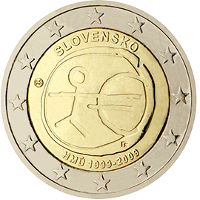 |
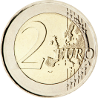 |
C o m m e m o r a t i v e
C o i n s |
||
| Slovakia | |||||||
The edge lettering of the Slovak 2‐euro‐commemorative coins is : (Slovak Republic) |
 |
||||||
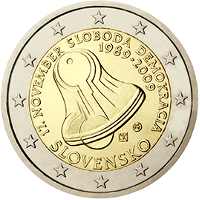 🔎
🔎 |
 |
Slovakia | 10 Nov. 2009 | 20th anniversary of the Start of the Velvet Revolution |
20001 20002 20005 |
1,000,000 |  |
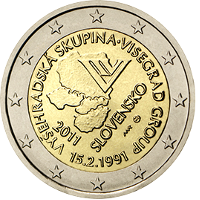 🔎
🔎 |
 |
Slovakia | 10 Jan. 2011 | 20th anniversary of Foundation of the Visegrád‐Group |
20001 20002 20005 |
1,000,000 |  |
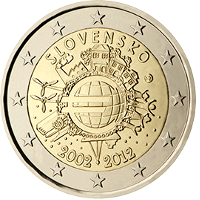 🔎
🔎 |
 |
Slovakia | 02 Jan. 2012 | 10th anniversary of the Euro‐Currency |
20001 20002 20005 |
1,000,000 |  |
National characteristics : At the top of the coin is the name of the issuing country "SLOVENSKO" (Slovakia). On the right between the images of residential houses and family is the mint mark "MK" between two embossing stamps of the Slovak mint Mincovňa Kremnica š.p. in Kremnica. |
|||||||
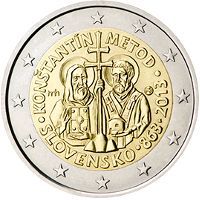 🔎
🔎 |
 |
Slovakia | 05 Jul. 2013 | 1150th anniversary of the advent of the mission of Constantine and Methodius to Great Moravia |
20001 20002 20005 |
1,000,000 |  |
 🔎
🔎 |
 |
Slovakia | 01 Apr. 2014 | 10th anniversary of the Slovak membership of the European Union |
20001 20002 20005 |
1,000,000 |  |
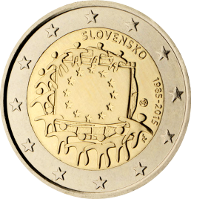 🔎
🔎 |
 |
Slovakia | 24 Sep. 2015 | 30th anniversary of the EU‐Flag |
20001 20002 20005 |
1,000,000 |  |
National characteristics : Above is the name of the issuing country "SLOVENSKO" (Slovakia), followed by the dates "1985‐2015". The mint mark "MK" between two embossing stamps of the Slovak mint Mincovňa Kremnica š.p. in Kremnica is shown on the right. |
|||||||
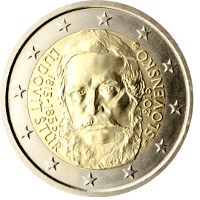 🔎
🔎 |
 |
Slovakia | 23 Oct. 2015 | 200th birthday of Ľudovít Štúr |
20001 20002 20005 |
1,000,000 |  |
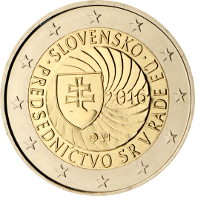 🔎
🔎 |
 |
Slovakia | 07 Mar. 2016 | Celebrating the Slovak Presidency of the Council of the European Union |
20001 20002 20005 |
1,000,000 |  |
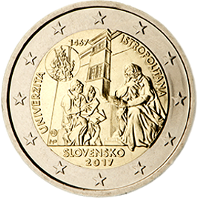 🔎
🔎 |
 |
Slovakia | 04 Jan. 2017 | 550th anniversary of the start of teaching at the Universitas Istropolitana |
20001 20002 20005 |
1,000,000 |  |
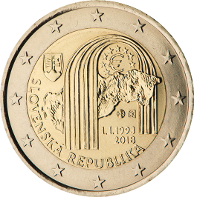 🔎
🔎 |
 |
Slovakia | 03 Jan. 2018 | 25th anniversary of the establishment of the Slovak Republic |
20001 20002 20005 |
1,000,000 |  |
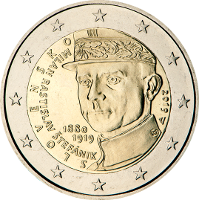 🔎
🔎 |
 |
Slovakia | 25 Apr. 2019 | 100th anniversary of Milan Rastislav Štefánik's death |
20001 20002 20005 |
1,000,000 |  |
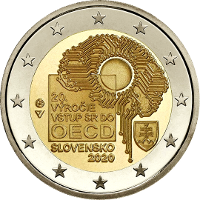 🔎
🔎 |
 |
Slovakia | 11 Nov. 2020 | 20th anniversary of Slovakian membership of the OECD |
20001 20002 20005 |
1,000,000 |  |
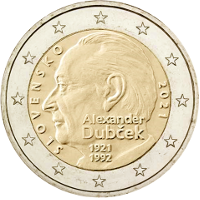 🔎
🔎 |
 |
Slovakia | 18 Nov. 2021 | 20th anniversary of Slovakian membership of the OECD |
20002 20003 20005 |
1,000,000 |  |
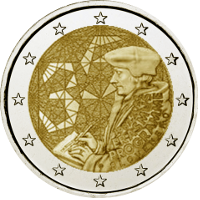 🔎
🔎 |
 |
Slovakia | 01 Jul. 2022 | 35th anniversary of the Erasmus Program |
20003 20005 20009 |
1,000,000 |  |
National characteristics : The quarter circle at the bottom right has four lines; below the commemorative period, the issue occasion "ERASMUS PROGRAMME" is written in two lines, below it is the issuing country "SLOVENSKO" (Slovakia). The mint mark of the Slovak mint Mincovňa Kremnica š.p. in Kremnica, an "MK" between two embossing stamps, is depicted on the bottom on the left sleeve. |
|||||||
 🔎
🔎 |
 |
Slovakia | 05 Oct. 2022 | 300th anniversary of the construction of continental Europe’s first atmospheric steam engine for draining mines |
20003 20005 20009 |
1,000,000 |  |
 🔎
🔎 |
 |
Slovakia | 02 Mar. 2023 | 100th anniversary of the first blood transfusion in Slovakia |
20003 20005 20009 |
1,000,000 |  |
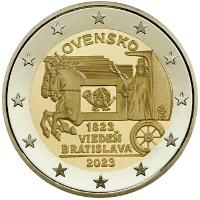 🔎
🔎 |
 |
Slovakia | 11 Oct. 2023 | 200th anniversary of the start of regular horse‐drawn express mail service between Vienna and Bratislava |
20003 20005 |
1,000,000 |  |
 Work in progress |
|||||||
| References : | |||
| 20001 | Images taken with authorisation by the ECB ‐ Mail dated 20.Feb.2020 © "European Central Bank" |
20002 | Data mirrored from Wikipedia Page "2_euro_commemorative_coins" with friendly support of the guardians of that page. |
| 20003 | Images taken with authorisation by H....... Hamburg | 20004 | Coloured version of this Commemorative Coin in circulation EU‐legal‐technical specifications do not recongnise colour prints. The EU nevertheless tolerates them, as their numbers are very small and they are sold in special packs and therefor are very unlikely to be used as currency. |
| 20005 |
enlarged Images taken with authorisation by Gerd Seyffert © "Gerd Seyffert 2021" |
20006 | Not Applicable |
| 20007 | Images taken by Münzen Kreuzberg © "Münzen Kreuzberg 2021" |
20008 | enlarged Images taken by Münzen Kreuzberg © "Münzen Kreuzberg 2021" |
| 20009 | Text with kind permission by Gerd Seyffert © "Gerd Seyffert 2023" |
20010 | Not Applicable |
 |
